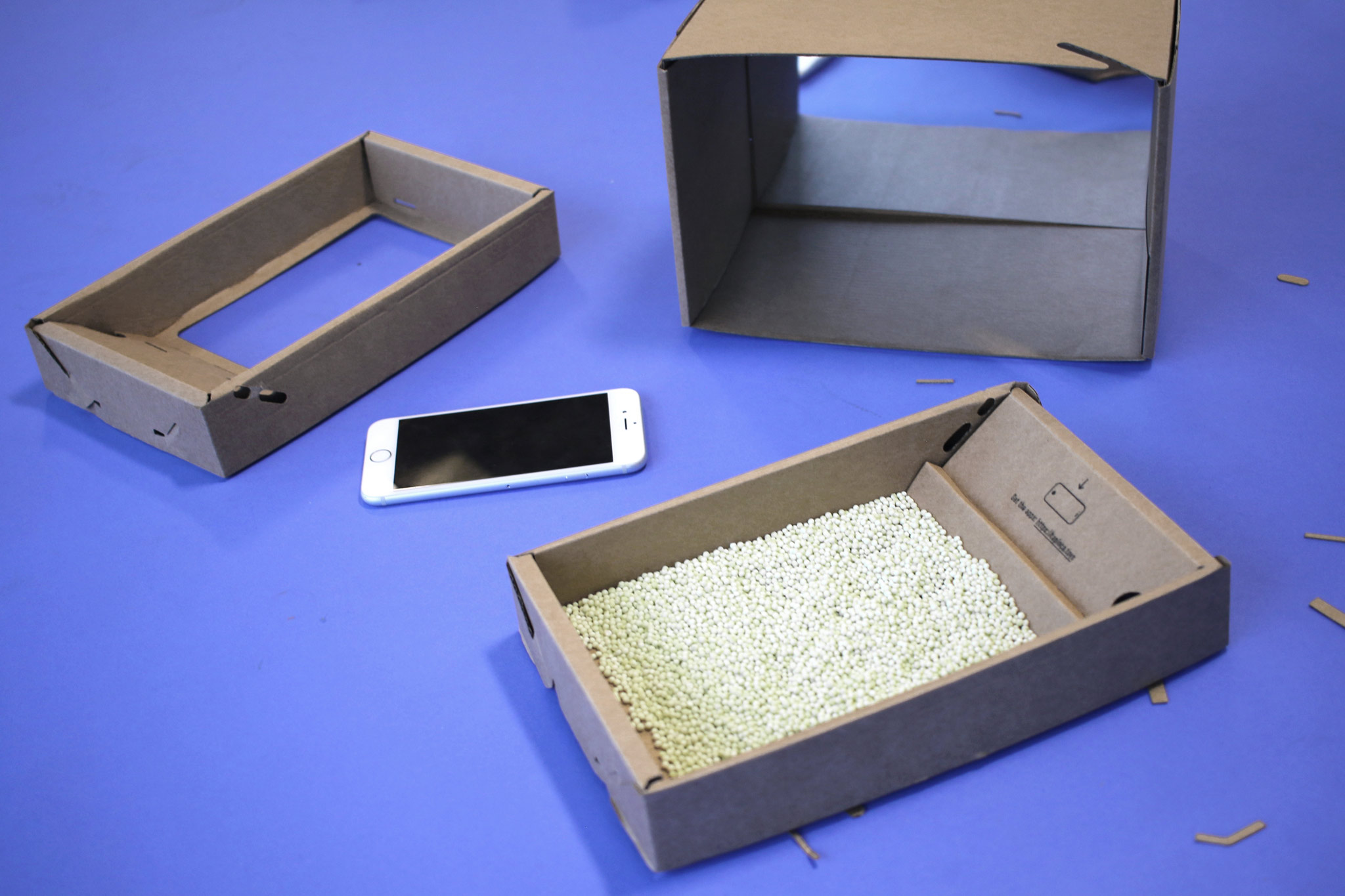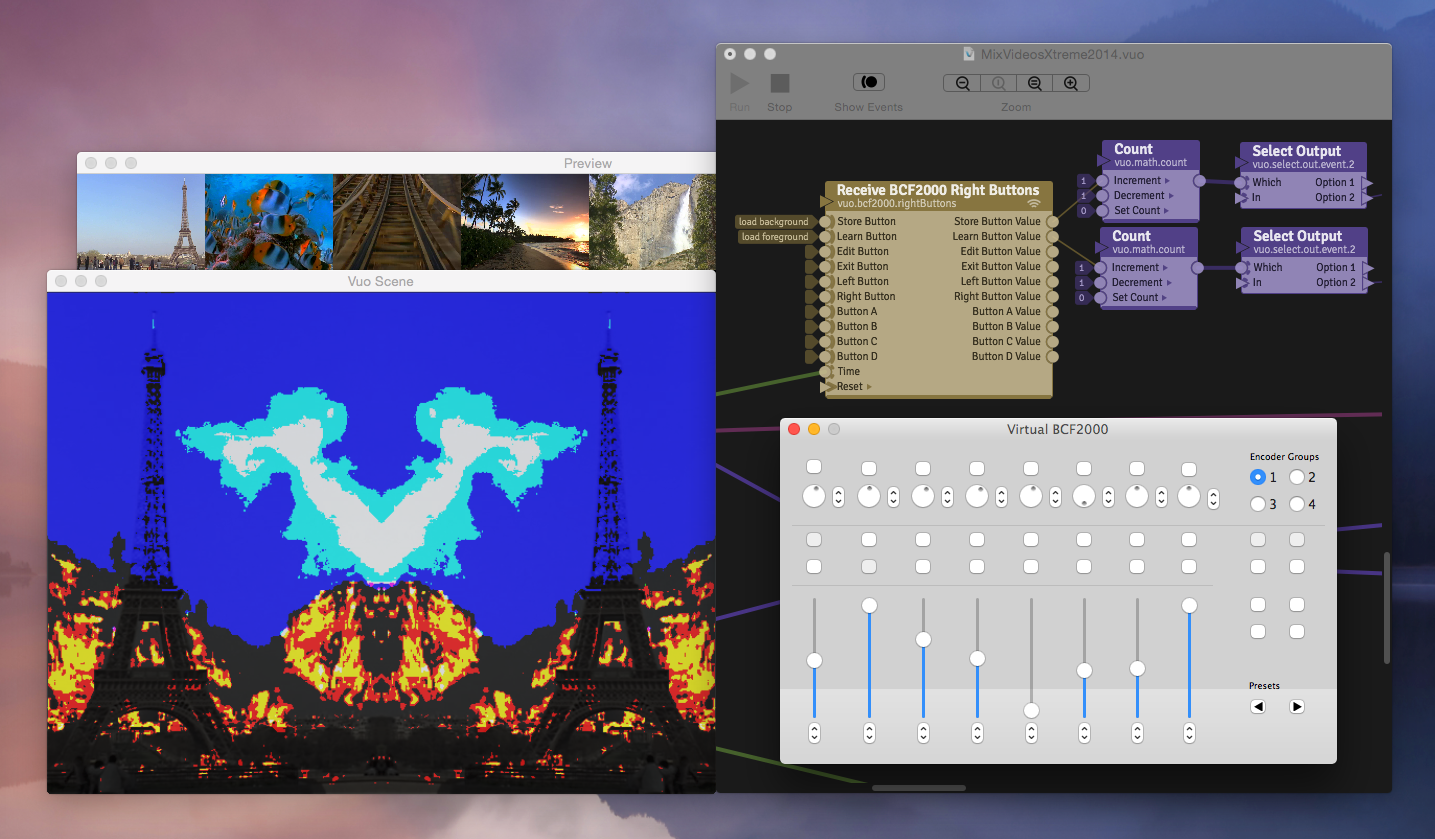

Originally captured as the medium for Ed Ruscha’s creative work, the more than 65,000 photographs selected from this archive present a unique view of one of Los Angeles’ quintessential streets, Sunset Boulevard, and how it has changed over the past 50 years. Ed Ruscha, with help from Getty and Stamen Design, is making this amazing collection accessible to you: explore his images of Sunset and discover your own story of Los Angeles.

Extreme Mercator projection with Marseille (France) as reference point (on the right side).
The map you see is the Mercator projection.
But unlike a standard Mercator projection, you can substitute any point on earth as the "pole". (The initial view shows Boston as the pole point)
Furthermore, this map cuts off much, much closer to the poles than normal, allowing you to see many more orders of magnitude of distortion.
Because this yields a map several times taller than it is wide, it is shown sideways from its usual orientation.
Backstory
The Mercator projection is infamous for its distortion at high latitudes. This distortion gets exponentially worse as you approach the poles. It is in fact impossible to show the poles on a Mercator map — they are infinitely far away.
Any Mercator map you've ever seen must cut off the top/bottom edges at some arbitrary point. The map usually stops hundreds, if not thousands of miles short of the poles.
But I've often wondered what lies beyond those cut-offs... to make a map that didn't cut off but simply kept going. As the distortion progresses towards infinity, you would eventually reach the scale of cities, houses, insects, atoms...
But of course that'd all be on a featureless expanse of ice.
To make things actually interesting, we must artifically shift the pole of the projection to a more interesting place. Imagine the earth encased by a rigid cage of latitude and longitude lines. We rotate the earth while leaving the cage fixed until a new point of interest has taken the place of the North Pole.
This is called an oblique Mercator, and is normally used to shift an area of interest onto the equator of the map to avoid distortion. But whereas others avoid the distortion, we embrace it.
Note how strange the oblique Mercator looks even without the increased cutoffs. The standard Mercator is so ingrained in the public consciousness that we perceive it as 'normal'. But once you shift the pole its pervasive distortion is shockingly apparent.
Evoboxx is a synthesizer based on the cellular automaton Game of Life, created by mathematician John Horton Conway in 1970. The game is a zero-player game, meaning that its evolution is determined by its initial state, requiring no further input. One interacts with the Game of Life by creating an initial configuration and observing how it evolves, or, for advanced players, by creating patterns with particular properties.
Tapioca Toys Cardboard
Real-world interfaces built to play music, mold landscapes, draw… for kids & grown-ups.
The Cardboard Edition is the latest-born of our tapioca interfaces. We're introducing this compact, low-cost and low-tech version that's easy for us to mail and easy for you to build. All it does require is an iPhone, and not necessarily the latest kind: versions 5 to X are compatible. To learn more about the why and the how, visit our lab article.


Vuo is a kit for making a million different projects — apps, videos, prototypes, plugins, exhibits, live performance effects, and more. Even if you don't have programming experience, Vuo lets you build your own stuff for Mac.
Vuo is the Finnish word for flow, and that's what Vuo is about — supporting your creative flow. When you're creating, you want to focus on your ideas. You don't want to be distracted or frustrated trying to figure out how your tools work. Vuo helps you stay in the groove by making it easy to find the building blocks you want, put them together, and tweak your creation until it's just the way you want it.

![]()
Chataigne is made with one goal in mind : create a common tool for artists, technicians and developers who wish to use technology and synchronize softwares for shows, interactive installations or prototyping. It aims to be as simple as possible for basic interactions, but can be easily extended to create complex interactions
Interface started out in late 2016 as an experiment to build a perfectly pixel–fitting font at a specific small size (11px.) The idea was that by crafting a font in a particular way, with a particular coordinate system (Units Per EM), and for a particular target rasterization size (11), it would be possible to get the best of both sharpness and readability.
However after a few months of using an early version of Interface, it dawned on everyone exposed to the test that this approach had some serious real–world problems. Most notably that it was really hard to read longer text. Because of the pixel–aligning nature of that approach, the font took an almost mono–spaced appearance, making it really easy to read numbers, punctuation and very short words, but eye–straining to read anything longer.
The project was rebooted with a different approach, sticking with the specific UPM, but crafting glyphs and kerning in a way that made for more variation in the rhythm and smoother vertical and horizontal stems. As Interface was being developed, it was tested on an internal version of Figma—where the author of Interface works as a designer—and slowly improved upon based on experience and feedback.
My good friend Tony Duggan-Smith built this musical (?) instrument for me, with the intention of using it in horror film score.
It consists of metal rulers which are bowed, a hurdy gurdy like mechanism, a string played with an attached Ebow, a spring reverb (also played with an ebow) some long metal rods, magnets, trash, anything at all to get unnerving sounds.
Open Stage Control is a libre desktop OSC bi-directionnal control surface application. It's built with HTML, JavaScript & CSS on top of Electron framework
Download here : https://github.com/jean-emmanuel/open-stage-control/releases
[ About Re:Sound Bottle -second mix- ]
Experimental sound medium that transforms recorded everyday sounds into music
[ Concept ]
• Allows anyone to create music using sounds from daily life
• Communication that arises from intuitive sound interaction
The conventional way of experiencing music is usually through existing technologies such as the ipod or the radio. However, this style of experiencing music takes place in a given form; is static and as a result leaves us dissatisfied.
To really enjoy music, we need to find music through sounds around us. We need to stop being tied down with new gadgets that provide the music for us, but to search for music ourselves.
A series of ideas like these lead me to create this device.
This creation's main concept is to record sounds from daily life. It is the concept of ‘collecting sounds in a bottle’. You choose the sounds collected in the bottle. Using everyday sounds as a musical component establishes a new understanding of the sounds we listen to everyday. By collecting your own sampling of sounds, you encounter a unique piece of music that can be experienced only once.
This device will bring a smile to anyone, as many will be able to experience the charm of music, leading them to turn music into something they love and adore.
Created by Jun Fujiwara

It can be a tricky task to debug and visualize realtime data on the Arduino board. You are usually stuck with the standard serial output, as the complexity of your Arduino code grows this makes it impossible to comprehend what is actually going on inside the board. To solve this I have created a little library that will enable you to create your own custom GUI for your Arduino projects.
WiSee is a novel interaction interface that leverages ongoing wireless transmissions in the environment (e.g., WiFi) to enable whole-home sensing and recognition of human gestures. Since wireless signals do not require line-of-sight and can traverse through walls, WiSee can enable whole-home gesture recognition using few wireless sources (e.g., a Wi-Fi router and a few mobile devices in the living room).
WiSee is the first wireless system that can identify gestures in line-of-sight, non-line-of-sight, and through-the-wall scenarios. Unlike other gesture recognition systems like Kinect, Leap Motion or MYO, WiSee requires neither an infrastructure of cameras nor user instrumentation of devices. We implement a proof-of-concept prototype of WiSee and evaluate it in both an office environment and a two-bedroom apartment. Our results show that WiSee can identify and classify a set of nine gestures with an average accuracy of 94%.
PixiVisor is a revolutionary tool for audio-visual experiments. Simple and fun, cross-platform application with unlimited potential for creativity! It consists of two parts: Transmitter and Receiver. Transmitter converts the video (static 64x64 image or 10FPS animation) to sound, pixel by pixel (progressive scan). This lets you listen to the sound of your image. But the main function of the Transmitter is to transmit the signal to the receiving devices. Receiver converts the sound (from microphone or Line-in input) back to video. You can set the color palette for this video, and record it to animated GIF file.

The "Water Light Graffiti" is a surface made of thousands of LED illuminated by the contact of water. You can use a paintbrush, a water atomizer, your fingers or anything damp to sketch a brightness message or just to draw. Water Light Graffiti is a wall for ephemeral messages in the urban space without deterioration. A wall to communicate and share magically in the city. Water Light Graffiti is a project of Antonin Fourneau (atocorp.free.fr/)
Recursive Drawing is an exploration of user interface ideas towards the development of a spatially-oriented programming environment.
Recursive Drawing is by Toby Schachman for his ITP thesis project Alternative Programming Interfaces for Alternative Programmers.
Touché proposes a novel Swept Frequency Capacitive Sensing technique that can not only detect a touch event, but also recognize complex configurations of the human hands and body. Such contextual information significantly enhances touch interaction in a broad range of applications, from conventional touchscreens to unique contexts and materials. For example, in our explorations we add touch and gesture sensitivity to the human body and liquids. We demonstrate the rich capabilities of Touché with five example setups from different application domains and conduct experimental studies that show gesture classification accuracies of 99% are achievable with our technology.
The Toolkit for Sensing People in Spaces (TSPS) works by extending the energy of a person, through face, body and other assigned detection technology and revealing a visual interpretation of that person through software.
Otomata is a generative sequencer.
It employs a cellular automaton type logic
Interaction archive aims to bring together interactive projects that explore interaction between man and the physical built environment.
The Artvertiser is a software platform for replacing billboard advertisements with art in real-time. It works by teaching computers to 'recognise' individual advertisements so they can be easily replaced with alternative content, like images and video.
The latter half of the 20th century saw the built environment merged with media space, and architecture taking on new roles related to branding, image and consumerism. Augmented reality may recontextualise the functions of consumerism and architecture.
Google mod
Laboratoire de recherche sur l'archivage de nouvelles formes de textes et d'oeuvres hypermédiatiques
The Art of DeTouch explores the manipulation of images related to the human form. Drawing photographs from existing online portfolio sites of professional re-touch artists, this application allows a user to explore precisely how the images were altered
Open Softwear is a book about fashion and technology. More precisely it is a book about Arduino boards, conductive fabric, resistive thread, soft buttons, LEDs, and some other things.
it reads the xml files that are being stored by the MSN, and makes a graphical display that allows to make comparisons between conversations with different people..
As the niche genre of software art expands beyond the web and into mobile devices, media artists are finding ways to integrate their work into a new form of business model.
We are three digital artists Marc Downie, Shelley Eshkar, and Paul Kaiser who create works for stage, screen, gallery, page, and public space.
YouCube allows you to map YouTube videos onto an interactive 3D cube and then save it to a database so you can show your friends. As you spin around a YouCube, the sounds of the different vi
OSCemote is a remote control application for the iPhone and iPod Touch. It lets you send Open Sound Control messages to other programs like Max/MSP, Puredata, Eyesweb, Processing, etc.
M o m e n t emagazine attempts to develop a culture of response to things seen, heard, read and otherwise encountered in exploratory forms of art.
A book that summarizes how the technology of interaction came into being and prescribes how it will advance in the future. Written by the designer who was there, who helped make it happen, who pioneered the digital revolution
SMSLib is a Java library for sending and receiving SMS messages via a GSM modem or mobile phone. It also supports some bulk SMS operators, by implementing their HTTP interfaces.
In the Optical Tone, the original software controls dynamic color of LED and is applied to select the colors of the graphic pattern painted on the wall.
Create Digital Music is a webzine and community site for musicians using technology. Our unique and influential audience reads daily for the latest news, tips, reviews, and features on digital music making.
Touche is a free, open-source tracking environment for FTIR-based multitouch tables.
The AirPiano is an innovative musical interface which allows playing and controlling software instruments simply by moving hands in the air.
CUBIT is an interactive surface for multitouch interactions. It was designed with the intention to redefine visual computing and depart from the mouse pointer paradigm.